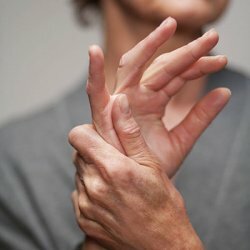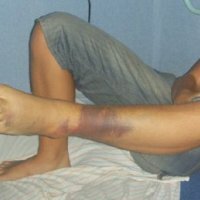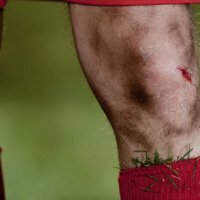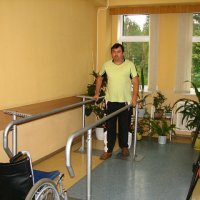Polyostoarthrosis of the fingers
 Polyostoarthrosis of the fingers is a serious disease. It is also called multiple arthrosis of the joints of the fingers or "knobby fingers".Most often this disease affects women. As a rule, arthrosis of the joints of the fingers is directly related to the hormonal changes in the body. This disease most often begins to progress during the onset of menopause - at the age of 45 years and older. The peak incidence falls on 50-60 years.
Polyostoarthrosis of the fingers is a serious disease. It is also called multiple arthrosis of the joints of the fingers or "knobby fingers".Most often this disease affects women. As a rule, arthrosis of the joints of the fingers is directly related to the hormonal changes in the body. This disease most often begins to progress during the onset of menopause - at the age of 45 years and older. The peak incidence falls on 50-60 years.
Causes of the disease
To date, scientists have not established a single cause of the disease. Some suggest that arthrosis of the finger joints is transmitted genetically. Perhaps, by inheritance, an unfavorable structure of the cartilaginous tissue of the joints or a metabolic disorder is transmitted. Because of congenital weakness during the climax, the cartilage of the joints is degraded and becomes inferior.
In this disease the cartilages lose their natural lubrication, as a result of which they crack and become dry. From the friction of articular cartilage, which "dried up," the inflammatory process begins in the joints. As a result, an inflammatory articular fluid is released, from which the joints burst from the inside. The patient complains of severe pain. If the disease is not treated, the joints begin to deform.
Not always polyostoarthrosis occurs due to hereditary predisposition. This disease can provoke other diseases. For example, diabetes mellitus, diseases of endocrine glands, thyroid disease, as well as metabolic disorders.
Symptoms of finger polyostoarthrosis
When a patient seeks a doctor with a complaint of pain in his fingers, the doctor immediately examines his hands. With this disease on the fingers of the hands there are special nodules: Bushar's nodules and Geberden's nodules.
Geberden's nodules appear on the lateral or back surface of the finger joints, which are located closer to the nails. As a rule, these nodules develop symmetrically, that is, on the left and right hand simultaneously in the same places. Nodules can appear on all the fingers. Their size can also be different: from a small grain to a pea. During the formation of nodules, the fingers often turn red and swell. The patient can feel a burning sensation and pain in the joints. Sometimes the disease runs without a trace.
However, in half the cases, during the course of the illness, there are often exacerbations. During such exacerbations, in those places where nodules appeared, there are also strong throbbing pains, which become less after the skin bursts over the bubble, and the contents drain out. If the vesicle does not burst, then the exacerbation can last up to several months. Then redness, pain and swelling disappear, and nodules become dense.
If during not to consult a doctor and not begin treatment, the polyostoarthrosis will progress: the deformation of the joints of the fingers will begin and the patient will find it difficult to move the fingers. From time to time there may be exacerbations - there will be nodules with burning and pain.
Bouchard's nodules are distinguished by the fact that they develop without exacerbations and slowly. Appear such nodules on the joints of the fingers, which are located in the middle of the distance between the nails and the base of the fingers. Bushard nodules, as a rule, arise on the lateral surfaces of the joints, as a result of which the fingers resemble a spindle-shaped form. Despite the fact that such nodules almost do not hurt, they violate the mobility of the fingers.
If you do not treat the nodules of Bushard and Geberden, they will lead to deformation of the hand. But, fortunately, this disease does not lead to disruption of the internal organs, as happens with arthritis.
Very often with nodules of Bushard and Geberden there is arthrosis of the joints of the thumb. This disease is also called rizartrozom. Risartrose affects the joint, which is located at the base of the thumb and connects the wrist joint with the metacarpal bone of the thumb.
As a rule, people suffering from rhizarthrosis, whose professions are associated with a high burden on the thumb. Also, the disease can develop in the event that the thumb was injured or heavily overloaded.
Risartrose gives the patient a lot of trouble. In addition to strong pain, a person feels a crunch in his finger, as well as his stiffness. As a rule, the pain becomes stronger when the finger is tried to move or with the load. Upon examination, the doctor in the patient with this disease immediately notices the deformation of the ossicles of the affected joint. This is clearly seen on an X-ray.
The thumb of the hand is most often subjected to various diseases, since it is very often necessary to load it. Therefore, if you feel pain in your thumb, you should immediately consult a doctor. Often on the thumb arises gout, psoriatic arthritis and other inflammatory processes. When there is swelling or redness, the patient should undergo a comprehensive examination to identify the disease.
Diagnosis of finger polyostearthrosis
As a rule, the diagnosis of this disease does not require much effort. It is enough for the doctor to look at the fingers to diagnose the disease. However, sometimes the symptoms of polyostearthrosis of the fingers are similar to other diseases. Therefore, doctors prescribe an additional examination to correctly diagnose. Most often, the patient is referred for blood tests( clinical) and tests for rheumatic tests, as well as radiography.
With polyostoarthrosis, the X-ray image clearly shows the main signs of the disease - the deformation of the bones of the patient's fingers, as well as the narrowing of the joint cracks in the affected joints. Analyzes of blood without abnormalities and all indicators remain normal.
Treatment of
disease If in time to detect the disease, it is easy to cure. To improve the cartilaginous tissue doctors appoint patients to take chondoprotectors - chondroitin sulfate and glucosamine. These drugs help to restore articular cartilage. To increase the effect of these drugs are also prescribed vasodilator drugs - theonikola or trental.
If the patient has consulted a doctor during an exacerbation of the disease, he will be prescribed non-steroidal anti-inflammatory drugs: ibuprofen, voltaren, indomethacin and the like. Such drugs relieve pain and inflammation.
Very often doctors prescribe to their patients ointments based on non-steroidal anti-inflammatory substances: voltaren - gel, fastum, ipdomometatsinovaya, butadionic and the like. Such ointments should be rubbed into the arthritic nodule at the time of its formation or exacerbation. Treatment consists of several courses lasting from 20 to 30 days.
In addition to ointments and gels, doctors prescribe lotions with bischofite. Bischofite is a substance that is produced when drilling oil wells. In other words, this is an oil derivative. It has anti-inflammatory and analgesic properties. Bischofite acts as a warming agent. Make a lotion with bischofite very easy. It is necessary to impregnate this bandage with a bandage and wrap every finger with a bandage. A polyethylene bag is put on top of the bandage, and cotton gloves( kitchen or garden) are placed over the package. Compress should be done two to three hours. The course of treatment - 20-30 procedures, which are done every other day.



